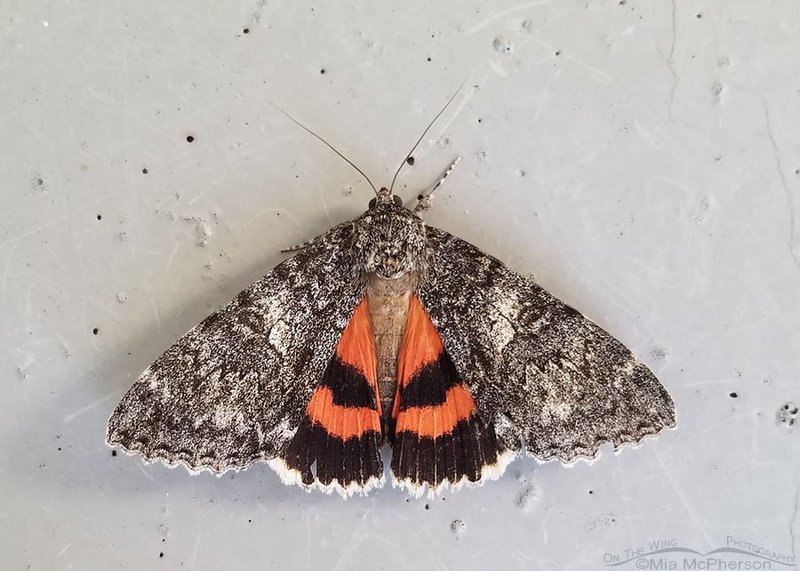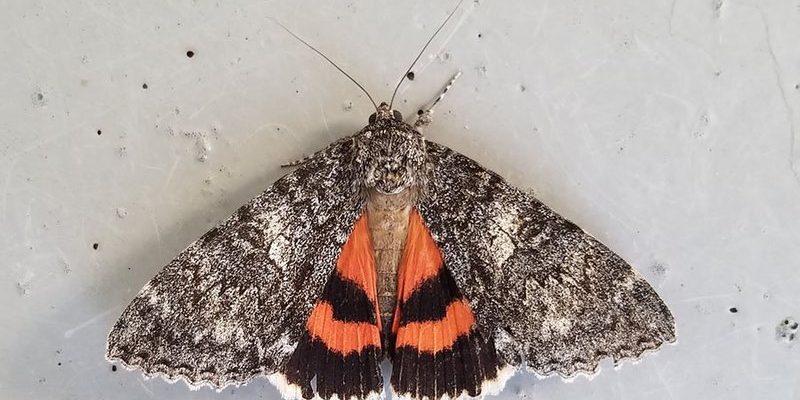
Have you ever stumbled across a moth and wondered about its life? The Underwing Moth, part of the Noctuidae family, is one of those intriguing creatures that often catches the eye, not just for its size but for its dramatic colors. When you first see one, it seems unassuming with its muted brown and gray wings. But when it flutters away, you’ll be amazed to see its vibrant underwings flash in shades of orange or yellow. It’s like a magician revealing their secret trick!
The name “Underwing” comes from this very characteristic. When these moths rest, their wings cover the bright colors underneath, keeping them safe from potential predators. This clever adaptation is nature’s way of providing camouflage. You might be wondering where these moths live or what they eat. Let’s dive deeper into the world of the Underwing Moth and explore what makes them so special.
Physical Characteristics
Underwing Moths are stunningly unique. Typically, they have wingspans ranging from about 2 to 4 inches. The forewings feature intricate patterns, providing an ideal blend of camouflage. These colors often include browns, grays, and blacks, helping them blend seamlessly into tree bark or leaf litter. However, when you catch them in flight, their underwings reveal a brilliant display of color. The striking contrast of vibrant orange and yellow, along with black markings, can leave you in awe.
Moreover, their bodies are plump and furry, adding to their overall charm. The females are generally larger than the males, a common trait among moths. You could picture the males almost as the more flamboyant dancers in the spotlight, while the females prefer a more subtle, graceful presence. This size difference plays a role during mating, where males showcase their bold colors to attract female partners.
Habitat and Distribution
You can find Underwing Moths in a variety of habitats, from forests to fields and sometimes even in urban areas. They thrive in regions where they can easily find their food sources and places to hide. Think of them as the ultimate survivors, adapting to different environments while maintaining their distinct flair. They are present across North America, and their specific species may vary by region. In some cases, you might spot them in your own backyard if you have a garden with native plants!
Most Underwing Moths prefer habitats with adequate moisture and diverse vegetation since their larvae, also known as caterpillars, often feed on various plant leaves. So, spotting one of these beauties might require a bit of patience and keen observation, especially since they tend to be more active during the night. If you’re an evening adventurer or an enthusiastic nighttime naturalist, chances are you’ll cross paths with them!
Diet and Feeding Habits
As larvae, Underwing Moths are quite the little eaters! They primarily feed on the leaves of certain plants, especially trees and shrubs. Oak, birch, and willow trees are among their favorites. Just imagine the munching sounds as they take bites out of leaves under the cover of darkness. They are known to be relatively picky eaters, which can affect their growth and development. After all, who wouldn’t want to indulge in a gourmet meal when given the chance?
As adults, the diet shifts. Underwing Moths are nectar feeders. They have long proboscises that help them sip on nectar from flowers. Think about them as nature’s pollinators; while they feast, they also play a role in helping various plants reproduce. You might spot them fluttering around moonflowers or evening primrose, showcasing their beautiful colors in the moonlight. It’s an absolute treat to watch them in action!
Behavior and Life Cycle
Underwing Moths have a fascinating life cycle that starts with eggs laid on the leaves of host plants. When the caterpillars hatch, they start munching away, growing rapidly and eventually moving to a pupal stage. This stage is like a transformative magic show, where they evolve into what we recognize as butterflies and moths. The metamorphosis can take several weeks depending on environmental conditions like temperature and food availability.
As adults, Underwing Moths are primarily nocturnal. They come alive when the sun goes down and have a unique way of navigating through the night. You might be surprised to learn that many species have the ability to detect light and use it to their advantage as they search for mates or food. They sometimes gather around lights, making them a common sight on porches during summer evenings. This is when you’ll really get to appreciate their vibrant underwings flashing in the dark.
Threats and Conservation
Like many wildlife species, Underwing Moths face threats from habitat loss, pesticides, and climate change. As urban development spreads, their natural habitats are destroyed, leading to population declines. Additionally, the use of chemicals in gardens and farms can be detrimental to their health. A single application of pesticides can wipe out not just moths, but entire ecosystems, which is quite alarming.
Conservation efforts are essential to protect these beautiful creatures. Initiatives supporting organic farming and the preservation of native plant species can help provide safe habitats for Underwing Moths. You can contribute to these efforts by creating a moth-friendly garden. Planting native flowers and avoiding pesticide use can make a significant difference. Think of your garden as a sanctuary, where these moths can thrive!
Fun Facts About Underwing Moths
- Underwing Moths are part of the Noctuidae family, which includes many nocturnal moths.
- Their bright underwings act as a warning signal to predators, letting them know they are not as tasty as they appear.
- Many species can be identified by their unique wing patterns and colors.
- Some Underwing Moths can reach speeds of up to 20 miles per hour.
Interesting Behaviors
One of the more charming aspects of Underwing Moths is their courtship rituals. Males will often flap their wings vigorously to attract females. Picture a bird dancing to impress its mate; it’s quite a sight! Additionally, when threatened, these moths will sometimes drop to the ground and lie still to avoid detection. It’s a clever blend of stealth and instinct. In many ways, they remind us that nature has its own set of survival skills.
You might also notice these moths playing a crucial role in the ecosystem by being part of the food web. Birds and other predators rely on them as a food source, highlighting their importance in maintaining ecological balance. So, while they may be delicate, they contribute significantly to the circle of life!
In summary, Underwing Moths are captivating creatures that offer much more than meets the eye. From their vibrant underwings to their unique feeding habits, these moths play critical roles in our ecosystems. By appreciating their beauty and understanding their needs, we can help ensure their survival for future generations. Next time you see one, take a moment to marvel at its colors and consider the fascinating life it leads.
FAQ
What are the different species of Underwing Moths?
There are several species of Underwing Moths, with some of the most common including the Catocala unijuga and the Catocala neogama. Each species has its own unique wing pattern and color, making them a delightful subject for moth enthusiasts and casual observers alike. Identifying the specific species can be a fun challenge for those who enjoy nature observation.
When is the best time to see Underwing Moths?
Underwing Moths are mostly active at night, particularly during the warmer months. Spring and summer evenings are the best times to spot them fluttering around lights or flowers. If you set up a light source in your yard, you may attract various moths, including the stunning Underwing Moth, making for a fantastic wildlife-watching experience!
Do Underwing Moths make good pets?
While it’s possible to keep Underwing Moths in captivity, they don’t make good pets in the traditional sense. Moths have short lifespans and specific habitat needs that can be challenging to replicate at home. However, observing and caring for them in a natural setting, such as in your garden, can be rewarding and educational.
What do Underwing Moths symbolize?
In many cultures, moths symbolize transformation and rebirth due to their metamorphosis from caterpillar to adult moth. The vibrant underwings of the Underwing Moth can also symbolize beauty hidden beneath the surface, encouraging people to look beyond appearances.
Can Underwing Moths be harmful to gardens?
Generally, Underwing Moths do not harm gardens as adults. However, their caterpillars may feed on leaves of certain plants, leading to some leaf damage. In most cases, they are not considered significant pests and can contribute positively to the ecosystem by pollinating flowers.
How can I attract Underwing Moths to my garden?
To attract Underwing Moths, consider planting native flowers that bloom at night, such as evening primrose or moonflowers. Adding a light source in your yard during warm months can also draw them in. Creating a welcoming environment with diverse plants provides food sources and safe resting places for these beautiful insects.
What role do Underwing Moths play in the ecosystem?
Underwing Moths contribute significantly to the ecosystem by serving as pollinators and as a food source for other wildlife, like birds and bats. Their presence helps maintain the balance in food webs, supporting various species within their habitats. Their lifecycle also enriches the soil as decaying larvae return nutrients to the earth.
Do Underwing Moths migrate?
Some species of Underwing Moths exhibit migratory behavior, traveling long distances to find suitable climates for mating and feeding. For example, during changing seasons, some moths may migrate to warmer regions. Observing this behavior can be quite fascinating to those who enjoy watching wildlife!
Are Underwing Moths harmful to humans?
No, Underwing Moths are not harmful to humans. They typically do not bite or sting, and their presence is more of a natural wonder than a threat. In fact, they can be great for the environment by contributing to pollination and acting as indicators of a healthy ecosystem!
How can I protect Underwing Moths?
You can help protect Underwing Moths by avoiding chemical pesticides in your garden, planting native plants that support their lifecycle, and creating habitats that allow them to thrive. Small actions, such as maintaining a diverse garden, can make a big difference in their survival.

